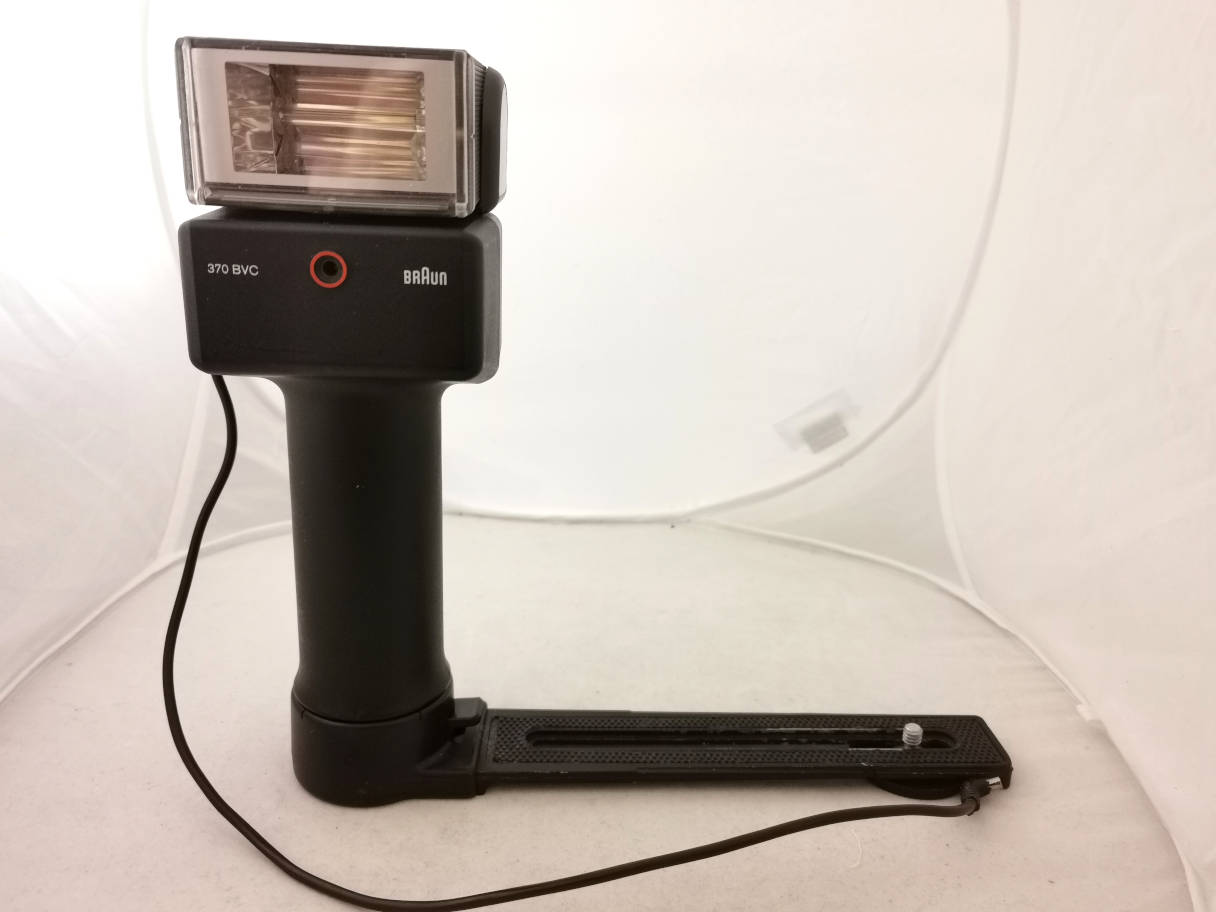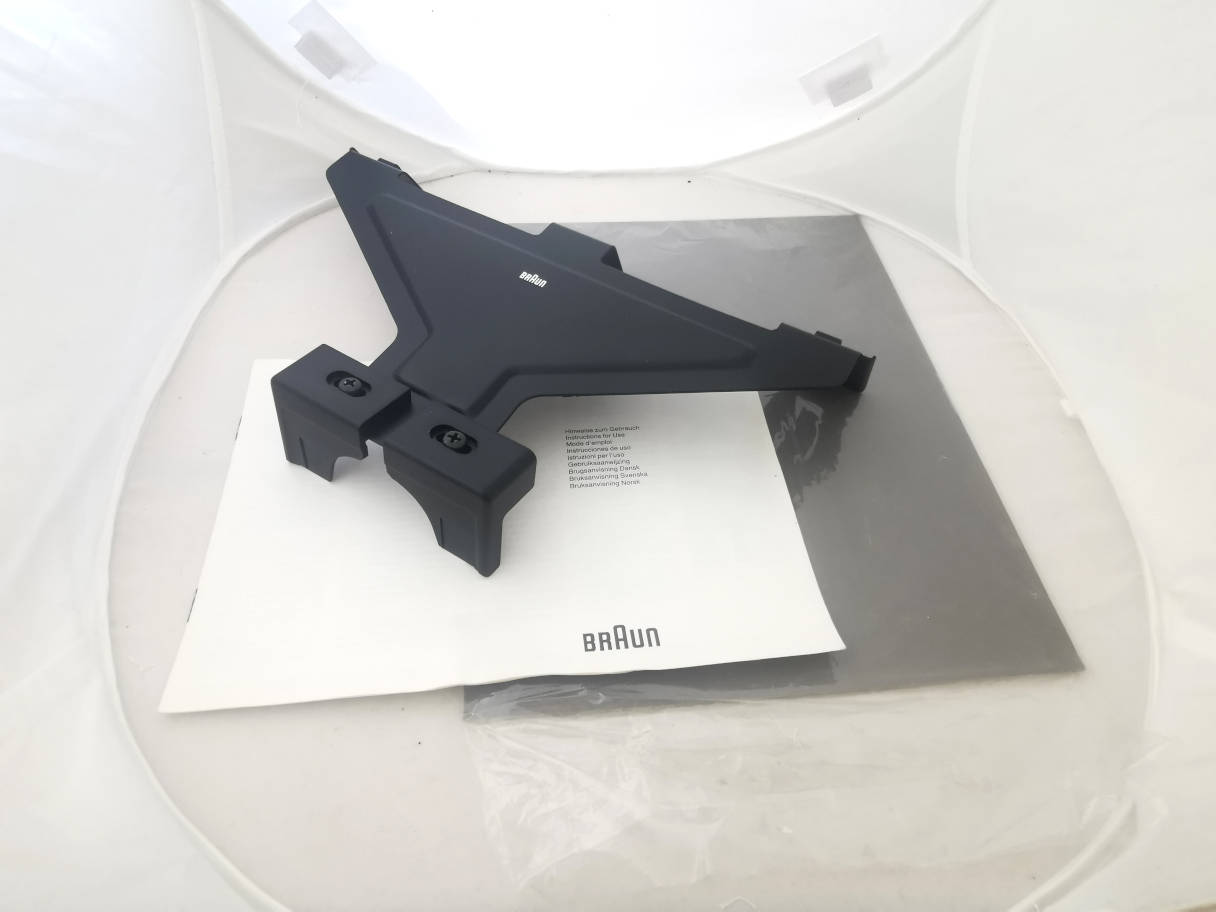OddCameras.com
Braun 370 (420) BVC
This
is a very versatile flash, a Braun 370 BVC or a Braun 2000
VarioComputer 370 BVC in full name. It's a battery flash that takes 4
ordinary AA batteries. There are bigger ones, like the BVC 420, and
smaller ones like the 320 BVC the latter has a more compact design. Some Pictures of the 420 are at the bottom of the page. As
these flashes date from the 1980s, I would not recommend the
rechargeable VC versions. You can use rechargeable batteries in the
ordinary battery flashes.
The flash has 3 operating modes, a "computer" mode, a manual mode and variopower mode.
There are quite some accessories, filters and diffusors, a very good reflector screen and adapters for different camera systems.
Some pictures:

A full set with filters, diffusors and reflector screen.

The
flash mounted on its bracket. The socket of the flash can also be
turned 180° in the bracket mount, so the flash can be to the right or
to the left of the camera. The mount is quite strong. If your camera is
not too heavy, the battery barrel of the flash is a good grip to hold
the unit.

The commands. 3 operating modes. On/off switch. Bottom left: ready light, right: test button. First thing to do: set the film ISO.
"computer" mode: the computer
will shut off the flash if and when the scene has got sufficient light.
Set the white index of the transarent lever to the chosen aperture of
the camera, 11 in the picture. You can now see up to which distance (m or feet) the flash will light the scene, a bit more than 3m or 10 feet in the picture (read the thinner index line if the wide angle diffuser is installed, about 2.2m or 7 feet in the picture).
Having taken the picture and fired the flash, a green light will show
for ~2 seconds in the center of the scales to indicate successful light
for the scene. So in case of doubt, test-fire the flash to see before
wasting a photo.
manual mode: the flash fires
full power, the tranparent lever is out of function, you may use it for
the ease of reading. Look at the chosen aperture to see the
distance it will cover below.
variopower mode: via the
transparent lever the flash can be set to fractions of its power, from
1/2 to 1/64 for the use of high speed film, very wide apertures and
very short and frequent flash times. Now it's the little window near
the center of the scales and the blue inscriptons to read. On the
picture it's 1/8 and the scale indicates that at F8 it would be 1.5m
and at F2 about 7m to be lit.
In manual mode the flash fires about 1/300s. A central shutter should
be set to 1/125. In variopower mode the times could be as short as
1/15000. A focal plane shutter must be set to its minimum full opening,
which is about 1/30, but check your camera manual.

Flash mounted on its bracket and cable.

The
head can be lifted for bounce flash up to 120° with a click-stop at
90°. Note the wide angle diffusor stored under the head. In manual mode
count both distances, flash-ceiling or wall + ceiling-object and add 1
stop. Computer mode gets it automatically right. Coloured refecting
surfaces give a tint to the photo.

The head can also be turned nearly 180° to either side with a click-stop at 90°.

The wide angle diffusor installed, just swing it up from below the head, it clicks into place..

Battery compartment, takes 4 AA batteries,

Battery
compartment lid. The locking system can become fiddly with age. Turning
the opening switch retracts two locking pins. If they don't move as
they should, you can push them in with the help of 2 small
screwdrivers, There a 4 square holes where they can go in., open to the
outside. Feel where they sit (they are always opposite to each other)
and push both in at the same time. The lid should come off.

Reflector screen and manual. The cardboard screen has a white and a
neutral grey side. The grey side is very handy for light measuring as
well.

The holder just slides under the ercted flash head. Computer mode takes everything into account.

Seen from the back.

A
full set of filters and diffusors, holder and instructions. The holder
fits on the bigger and the smaller flashes. There are colour filters, a
neutral ND4 filter and a conversion filter for the use of tungsten
(lamplight) film. You can insert 2 filters to combine colours. There is
a 28mm very wide and a 21/24mm ultra wide diffusor. And there is a UV
filter.

Holder installed on the flash.

With ultrawide diffusor.

With blue filter.
The yellow "K" setting was for Kodak Instant
cameras. You needed a special cable. Mode switch and transparent lever
had to be set to K. The cable connector held the camera aperture open
and the flash imitated the flash of a bulb. Darken/lighten settings are
indicated on the flash scale.
For the use on Polaroid SX cameras, there was a different approach. You also need a special cable. Mode
switch and transparent lever have to be set to P. Via the connector the
camera goes into flash mode and it's the camera which chooses the
aperture according to the distance. I have made a separate page on my Instant Cameras site. It opens in a new window.
As promised, some photos of the 420 BVC. It's a bit more powerful, a
bit younger and it has a much better locking system for the battery
compartment. But it lacks the Kodak and the Polaroid settings.

420 BVC front with wide angle diffusor.

420 BVC back. Full mode and 3 ranges switch.

Battery compartment lid with simple screw locking system.


















